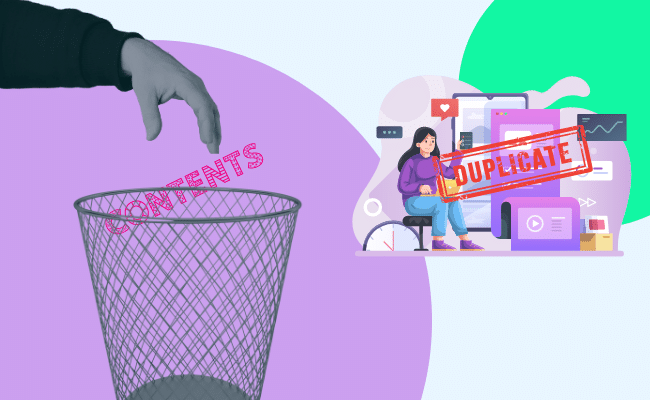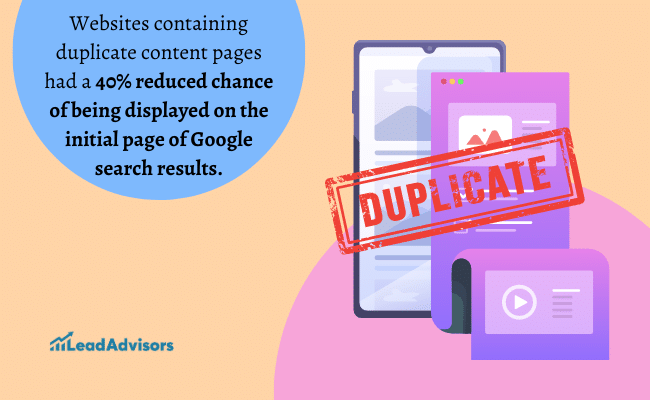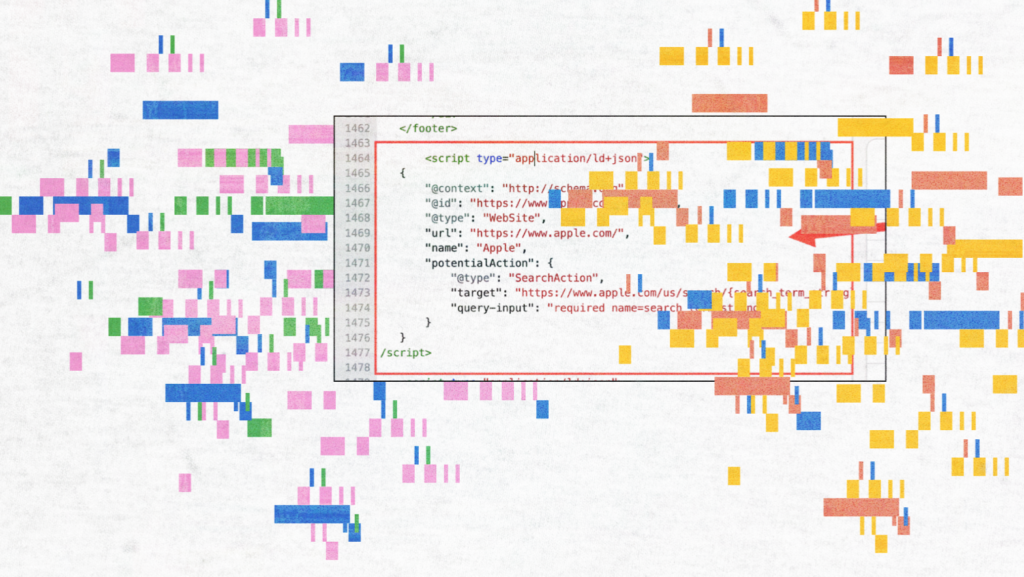As an e-commerce or business owner, you know that your website is your online storefront. It’s where potential customers learn about your products or services and make a purchase. This underscores the significance of ensuring that the product pages on your website contain top-notch, original content. This means that duplicate content must be eliminated.
Creating different and authentic content on a website sets you apart from competitors while enhancing your search engine optimization (SEO) standings. Having unique and original content on your website increases the likelihood of search engines assigning higher rankings to your pages. Consequently, this can result in increased website traffic and improved sales potential.
Suppose your goal is to improve your website’s SEO rankings and ensure a positive user experience for visitors. In that case, it is crucial to remove duplicate content found across various sections and in multiple versions of your site. This in-depth guide will guide you through a systematic approach to successfully tackle and resolve problems related to duplicate content.
Why Is Having Duplicate Content An Issue For SEO?
Including duplicate content on your website can adversely affect your search engine optimization (SEO) rankings and the overall user experience. Moreover, duplicate content refers to content on multiple websites with the same URL. It can be the exact duplicate content as on one page on other sites, an article URL on other sites, or similar content on multiple different URLs.
Recent research from 2025 confirms that duplicate content significantly harms a website’s SEO by reducing its chance of appearing on the first page of Google search results by around 40%, cutting backlink effectiveness by about 50%, and lowering conversion rates roughly 30%. This happens because duplicate pages confuse search engines, dilute backlink authority, waste crawl budget, and degrade user experience.
Effective SEO strategies, such as using canonical tags, 301 redirects, content audits, and noindexing duplicates, remain essential to mitigate these impacts and maintain strong search rankings, backlink strength, and conversion performance.
What is Duplicate Content?
Duplicate content refers to content found on multiple websites or pages, appearing in more than one location. It can, for the most part, be a duplicate version of the same content in various versions, or it can be very similar or identical to original content elsewhere on the site. Duplicate content can be intentional or unintentional.
Types of Similar Content
There are three main types of duplicate content:
- Exact duplicates: These are pages that contain the same content.
- Near duplicates: These are pages that contain very similar content.
- Scraped content: This is content copied from another website without permission.
Common Causes of Duplicate Content
Websites can experience duplicate content for various reasons. Some of the most common causes of duplicate content include:
- Many website owners make the common mistake of using the same content on multiple pages. For instance, you might have identical product descriptions featured on multiple pages.
- Using syndicated content: Distributed across multiple websites, syndicated content offers a means to incorporate new material into your website. Nevertheless, it is essential to acknowledge that engaging in this practice can lead to issues associated with duplicate content.
- Crawlers and spiders: Automated programs known as crawlers or spiders traverse the internet and index various web content. Then, these programs can index duplicate content, leading to problems with your SEO rankings.
- Hacking: Hackers can sometimes upload duplicate content to your website. This serious problem can damage your website’s reputation and hurt your SEO rankings.
The SEO Impact of Duplicate Content
Duplicate content is a significant problem for e-commerce and business websites. It can hurt your SEO rankings, confuse users, and damage your brand reputation, so most companies eliminate them.
How Search Engines Handle Duplicate Content
Search engines such as Google utilize multiple criteria to determine the positioning of websites in their search results. One of these criteria is the uniqueness of content. Search engines prioritize ranking pages on websites that feature distinct and original content.
When duplicate pages with identical content search functionality are identified, search engines may encounter difficulty discerning duplicate content issues from the original page from duplicate documents. Consequently, the ranking of your duplicate page content penalizes the search engine results, and your pages within their search results may be adversely affected.
Potential Penalties for Duplicate Content
Search engines such as Google employ a range of criteria to establish the positioning of websites within their search results and manipulate search engine results. One crucial factor is the uniqueness of content. As can be seen, search engines prioritize websites with deceptive and manipulate search- and manipulate search engine results and result pages with original and unique content.
When a duplicate page with search functionality or pages with the exact same content are found, search engines may need help identifying the original page. As a result, the rankings of your pages in search results may be negatively impacted.
Negative Consequences for SEO Rankings and Organic Traffic
Duplicate or duplicated content can negatively affect your SEO rankings and organic traffic. In essence, some of the most common consequences of using duplicated content, duplicate content penalties, or duplicate content include:
- Lower rankings in search results
- Fewer backlinks
- Less organic traffic
- Lower conversion rates
Duplicate content still hurts websites in 2025 by making it harder for Google to choose which page to show, splitting the value of backlinks across copies, wasting search engine resources, and confusing visitors. This leads to less traffic, weaker SEO, and fewer sales. To fix this, websites should mark preferred pages with canonical tags, use redirects, check for duplicates regularly, and remove or update repeated content to keep their rankings and conversions strong.
This research demonstrates the substantial adverse effects of duplicate content on SEO rankings and organic traffic. Eradicating duplicate content is crucial to enhancing your website’s performance.
Identifying Duplicate Content on Your Website
When search engines find duplicate content on blocking pages, they may need to rank pages on the search result pages on your web pages higher than they would if the content on search result pages were unique. This can hurt your website’s traffic and sales.
Moreover, multiple website versions provide several methods to detect and eliminate duplicate content across the site, across various locations, and move duplicate content to separate pages.
Manual checks
One can manually review a website’s pages to detect duplicate content. Although this process can be time-consuming, it is an effective method of identifying any instances of duplicate content that automated tools may have missed.
To manually check for duplicate content on separate pages on a website, start by opening a list of your website’s pages. Then, open each page and compare duplicate content issues on the site to see if they appear on the other pages of your website. If you find any separate pages containing the very same content or similar to the same content, you’ve discovered duplicate content on one page.
Plagiarism detection tools
There are several plagiarism detection tools available online. Generally, these tools can help you identify duplicate content by comparing your site or website’s content to others.
Indeed, to utilize a tool search console for detecting plagiarism, input the URL of the desired web page into the search console provided by the tool search console. The tool search console will then scan the page and return a list of websites with content similar to or identical to a particular page.
SEO auditing tools
There are also several SEO auditing tools available online. A reliable one is using a duplicate content checker that can help you identify various problems with your website.
To utilize an SEO auditing tool, input your website’s URL into the tool. Subsequently, the tool will examine your website and generate a report outlining any identified issues.
After determining the extent of duplicate content on your website, it becomes essential to address and resolve this issue. Consider implementing the following suggestions to rectify the problem:
- Eliminate duplicate content: To enhance your search engine ranking and create a user-friendly website, it is advisable to eliminate any non-valuable duplicate content present on your site. By removing such content, you can improve your website’s visibility and enhance the overall browsing experience for your visitors.
- Establish canonical URLs: To address valuable duplicate content, it is recommended that you establish canonical URLs. These canonical URLs serve as the preferred versions of pages, informing search engines about the specific page version to index.
- Use noindex tags: To prevent search engines from indexing duplicate content that holds no significance, you can utilize noindex tags. Correspondingly, these tags instruct search engines to exclude a particular page from their indexing process.
How to Eliminate Duplicate Content Issues
It is crucial to take proactive steps to resolve the above duplicate content penalty and other duplicate content, page content penalties, and other content duplication issues. By following the techniques and strategies below, your content management system can ensure your website provides unique and valuable content for each page, improving your SEO rankings and user experience.
Canonicalization
One effective technique for eliminating duplicate content problems is canonicalization. This involves specifying the preferred version of a webpage when multiple URLs contain similar or identical content. To implement canonicalization, follow these steps:
- Identify the duplicate pages or URLs on your website.
- Choose the canonical version of the content, which is the preferred and most relevant page.
- Insert a rel=”canonical” tag in the HTML code of the duplicate pages, pointing to the canonical version.
- Ensure that the canonical URL is crawlable by search engines and that it leads to the correct page.
301 Redirects
Another method to resolve duplicate content issues is by using 301 redirects. This technique redirects duplicate or outdated URLs to the correct and preferred version. Here’s how you can implement 301 redirects:
- Identify the duplicate pages or URLs that need redirection.
- Implement a 301 redirect from the duplicated URL to the authoritative or preferred version.
- Update internal links, sitemaps, and external references to the canonical URL.
- Test the redirect to ensure that it functions correctly.
Meta Tags
Meta tags, specifically the meta description, play a crucial role in differentiating your pages and eliminating duplicate content confusion. Follow these steps to optimize your meta tags:
- Craft unique and compelling meta descriptions for each page, summarizing the content and enticing users to click.
- Ensure that meta descriptions accurately reflect the specific content of each page.
- To prevent confusion among search engines and users, avoiding using identical meta descriptions on multiple pages is essential.
Create Unique and Valuable Content
Developing original and valuable content for every page is critical in addressing problems related to duplicate content. By doing so, you provide search engines with distinct signals for indexing and ranking. Here are some best practices to follow:
- Conduct thorough research and create original content that adds value to your target audience.
- Eliminate duplicate content on your site.
- Ensure each page has a specific focus and provides unique information or perspectives.
- Incorporate relevant keywords naturally into your content to enhance its SEO value.
- Use an internal linking strategy to connect related pages and guide users through your website.
Preventing Duplicate Content in the Future
Duplicate and quality content can also harm your website’s SEO rankings and user experience. To ensure your e-commerce or business website stays free from both technically and technically duplicate content and issues or content duplication issues and quality content issues, consider implementing the following best practices and strategies:
URL Parameters
Understand how URL parameters affect your website’s content. At this point, avoid creating multiple versions of the same page by properly handling URL parameters. Use Google Search Console or Bing Webmaster Tools to set URL parameters correctly and eliminate duplicate content issues.
Pagination
If your website includes paginated content, such as blog archives or product category pages, take steps to prevent duplicate content. Implement rel=”next” and rel=”prev” tags to indicate the relationship between paginated pages. Additionally, use canonical tags to specify the preferred page for search engines.
Faceted Navigation
Faceted navigation, commonly used in e-commerce websites, can generate duplicate content problems. Implement a faceted navigation strategy that ensures each combination of filters and parameters leads to a unique URL. Use rel=”canonical” tags to consolidate the value of filtered pages to the main category page.
Content Creation
Focus on creating high-quality, unique content for your website. Avoid duplicating content from other websites by creating original material or through strategies like guest blogging. Conduct a content gap analysis to identify instances of duplicate content and take immediate action to resolve them.
Internal Linking
Strategically interlinking your content helps search engines comprehend your website’s organization and layout. This minimizes the likelihood of encountering problems with duplicate content.
Proper Use of Canonical Tags
Canonical tags are essential for indicating the preferred version of a page when duplicate content exists. Implement canonical tags on duplicate or similar pages to consolidate their ranking signals to the preferred page. This helps search engines understand which page should be indexed and ranked.
Frequently Asked Questions
Does Google penalize websites for duplicate content?
How can I check for duplicate content across multiple domains?
Can duplicate content happen in product descriptions?
Is translated content considered duplicate?
How often should I audit my website for duplicate content?
Conclusion
To summarize, duplicate content is a significant problem for e-commerce and business websites. It can hurt your search engine rankings, reduce your website traffic, and even lead to penalties from search engines.
Moreover, implementing these measures can enhance your website’s search engine ranking and increase traffic. For assistance with eliminating duplicate content and improving your website’s SEO, contact LeadAdvisors.
Discover how LeadAdvisors can assist you in creating a tailored strategy to get more traffic and enhance your own website’s effectiveness. Explore our services now to gain insights on optimizing your website, your own site’s SEO, and improving user experience.

















